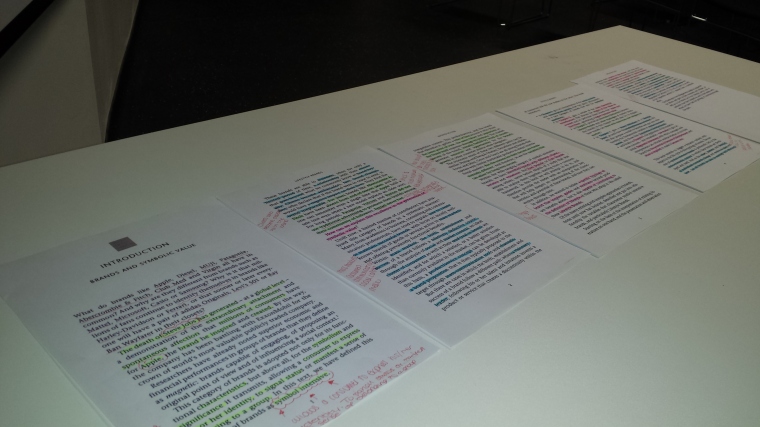NAME
Melissa Stapleton
TITLE OF RESEARCH PROJECT
Customer Relationship Marketing – Selling people A constructed dream rather than a product
MODE OF PRESENTATION SELECTED
Symposium Presentation
The reason I have chosen a symposium presentation to discuss my topic is because I feel that I will be able to show my research a lot better through using photographs and videos to gain my audiences attention and for them to understand and engage with my topic through imagery.
INTRODUCTION
To discuss the main techniques used in advertising, to see how they sell a lifestyle, rather than a product, which are used in American Fashion brands and how this impacts the viewer, specifically aimed at young adults, between the ages of 15 and 25.
The main techniques used within advertising, looking mainly at language and imagery, and how this impacts on the viewer.
Looking at how lifestyle brands are an attempt to sell an identity, or an image rather than a product. Brands call attention to ‘who’ would use this product or what ideals it represents, as opposed to what the product actually does.
For example, Jack Wills positions itself as a University outfitters and looks to attract ‘fabulously British’, ladies and gentlemen of that age. To the outside world Jack Wills kids play lacrosse, they sail, ski, have lots of friends and are effortlessly attractive because of their lifestyle and clothes they wear.
Digital platforms also reinforce the power of word of mouth and brands are paying attention. Marketers understand that retweets and likes are the digital equivalent to passing a thumbed novel onto a friend.
I will firstly start by looking at fashion brands, such as Jack Wills, American Apparel and Abercrombie and Fitch. Looking at how they sell their lifestyle brands and how digital platforms reinforce this.
DESCRIPTION OF SPECIFIC SUBJECT TO BE INVESTIGATED
I want to explore and discuss the information found when researching my topic, (‘Customer Relationship Marketing – Selling people A constructed dream rather than a product’), I am going to research the main techniques using fashion advertising, paying attention to the language and imagery to sell the lifestyle brand, looking at brands such as, Jack Wills, American Apparel and Abercrombie and Fitch.
We assume we can tune most of advertisements out. If we don’t pay attention to advertisements then they won’t affect our behaviour. In the journal of consumer research, a study took place by Melanie Dempsey and Andrew Mitchell, who found that we should be more aware of our exposure to advertisements. They found that putting a new product next to another which we already think positively about, will impact on a new product. This is known as affective conditioning. This theory works best when you are unaware that this is happening.
I will pay close attention to digital platforms and how these brands reinforce their lifestyle,
KEY IDEAS
Techniques – Language – does it break the rules of ‘normal’ language? – Figures of rhetoric in advertising language by David Mick
Imagery and Effects on buyers – ‘Advertisers have long realised the importance of advertising that creates mental images in the buyer’s mind’
Lifestyle Brands – Selling a lifestyle rather than a product
Digital platforms – how does this reinforce the idea of lifestyle branding and customer relationships.
SOURCES TO BE UTILISED
I want to utilise theoretical books, especially those which discuss the topic on which my question is based on. This is where the majority of my research will come from, along with online articles that talk about my key topic areas. Along with these materials, I am also going to use case studies (newspaper articles) where people have been affected by advertising brands. Along with gaining feedback from others on how they feel when watching/looking at a particular advertisement.
RESULTS/FINDINGS
I will break down my question into topics that I am going to discuss, What is lifestyle branding?, how brands create a lifestyle, digital platforms to reinforce their lifestyle and how this then impacts people (through using case studies). I will then begin to categorise my information into the relevance of my research and any crossovers will evidence and prove my found research.
From here I will then be able to construct my own opinions and connections within my topic/research and start to build the main on my presentation.
METHODS/FORMS OF INTERPRETATION/ANALYSIS TO BE USED WITH THE
INFORMATION AND SOURCES
Making full use of the university library and their ‘Locate’ system. Be in conversation with lecturers who are more familiar with this area ‘Advertising’. I will do this by setting up meetings, in person or through Skype, along with on-going emails. I will also talk to my peers to gain their views on my topic and the research which I have found, not only will I speak to my peers, but others outside of my social circle. I can do this by using social networking sites, such as Google plus and twitter. As all these people may have been exposed to information, which may be of use to my research.
PLAN/ SCHEDULE OF WORK
October – November – Gather books, find relevant articles and understand them. Find case studies to back up my findings. Along with finding the relevant practitioners which I wish to connect with and build a rapport.
November – Rough copy of proposal
December – Have proposal ready. Take advice and constructive criticism to help with further direction for presentation.
December – January – Keep researching. Have most of my research and started to put it into a presentation.
January – Have presentation. Constructive criticism. More research if necessary.
January – February – PRACTICE PRACTICE PRACTICE – spend time on pace and actual presentation skills.
BIBLIOGRAPHY (in addition to the 500-700 word limit)
http://www.stanford.edu/class/linguist34/
http://www.academia.edu/668339/Figures_of_rhetoric_in_advertising_language
http://www.acrwebsite.org/search/view-conference-proceedings.aspx?Id=5909
http://www.buynothingday.co.uk/
http://www.dailymail.co.uk/news/article-2126172/Chinese-boy-sells-kidney-buy-iPad-iPhone.html
http://www.amazon.com/The-Waste-Makers-Vance-Packard/dp/1935439375
http://www.theguardian.com/media-network/partner-zone-brand-union/lifestyle-brands-creating-positive-experience









